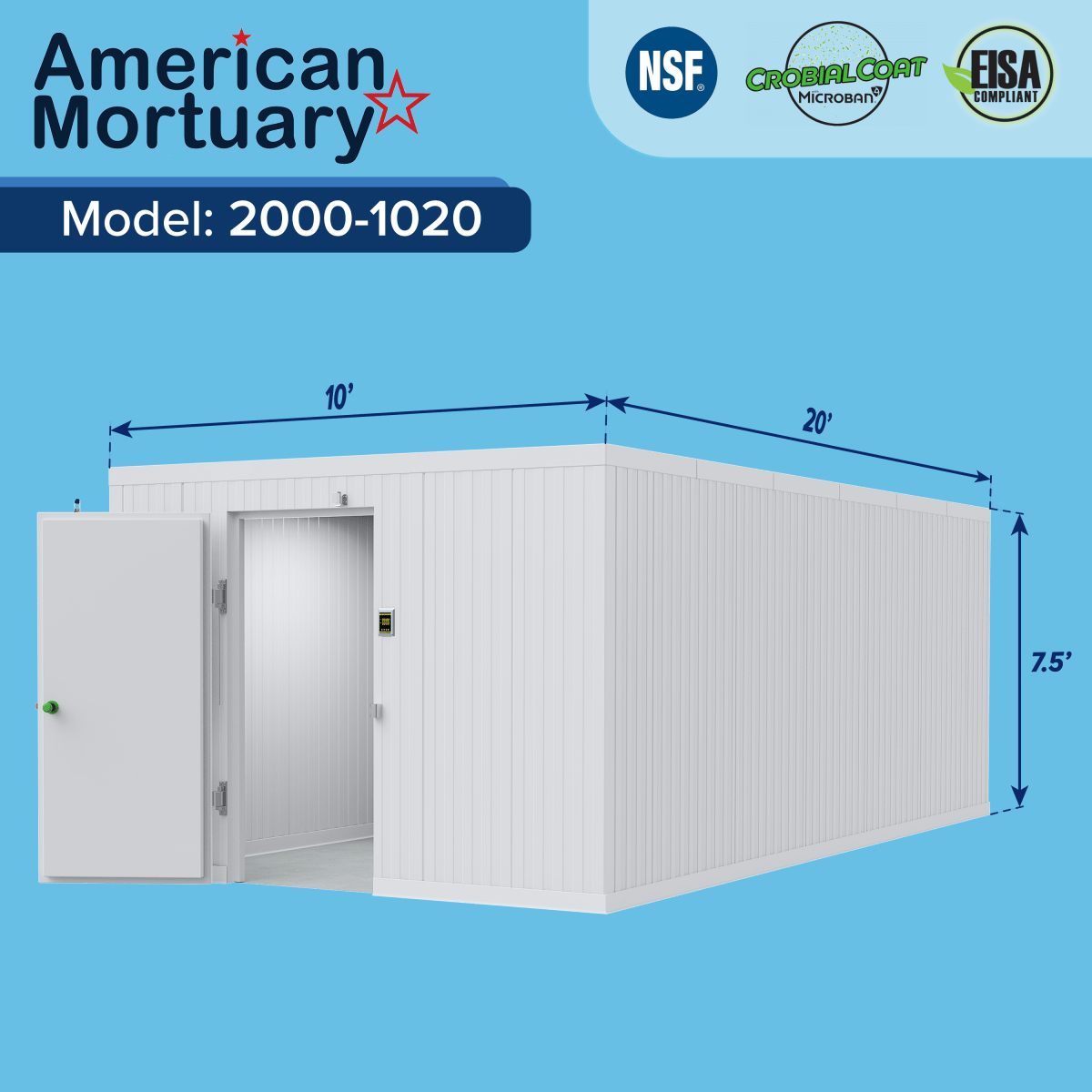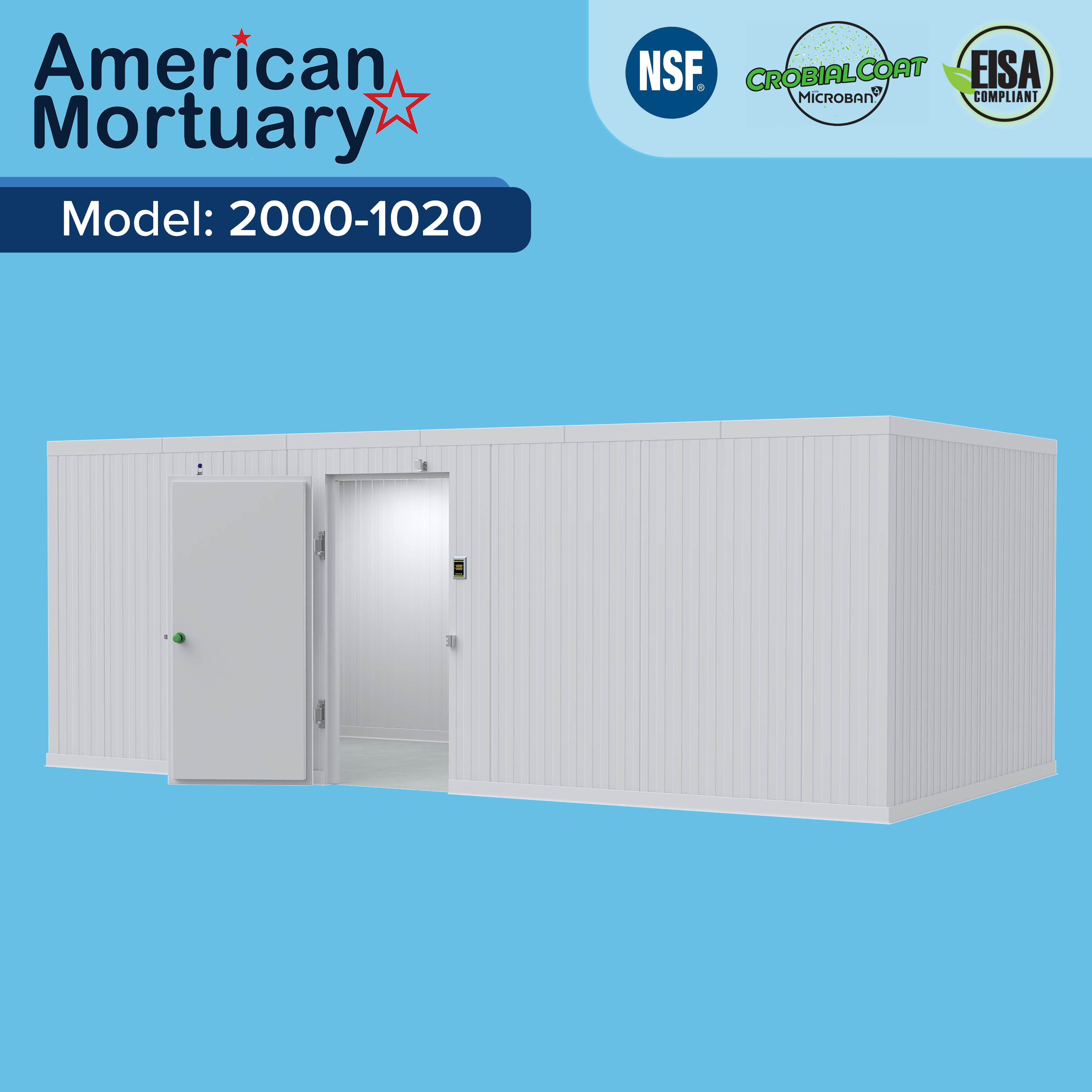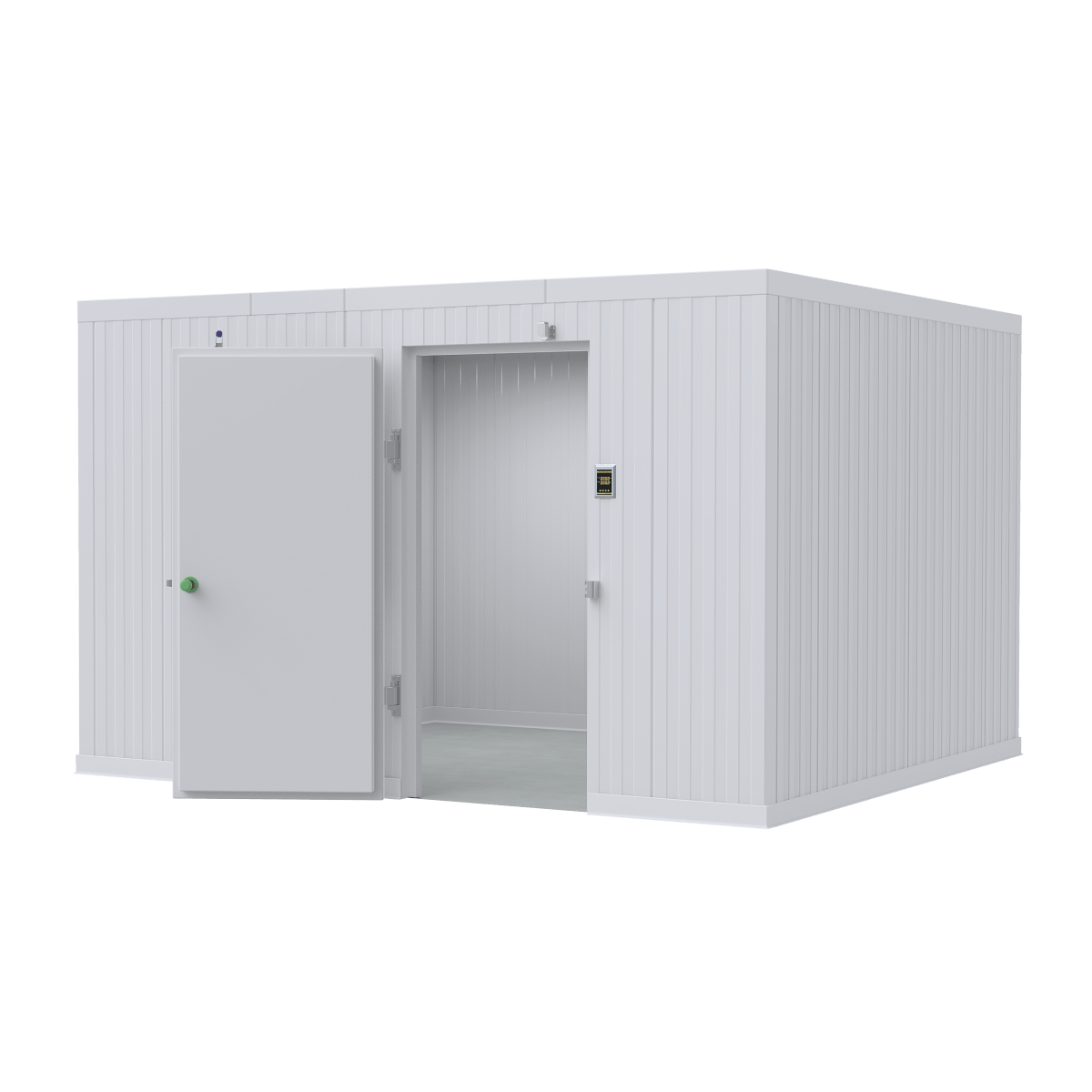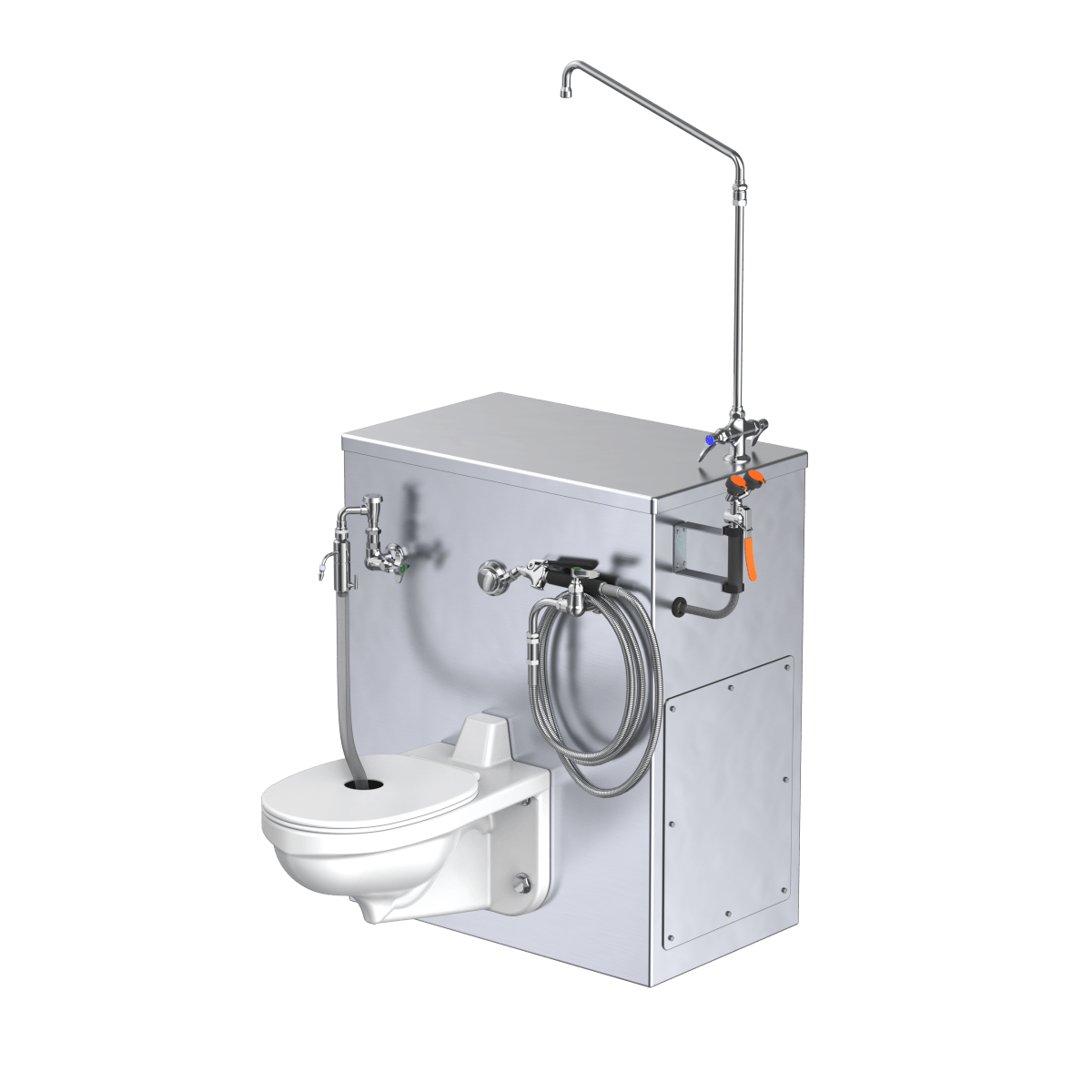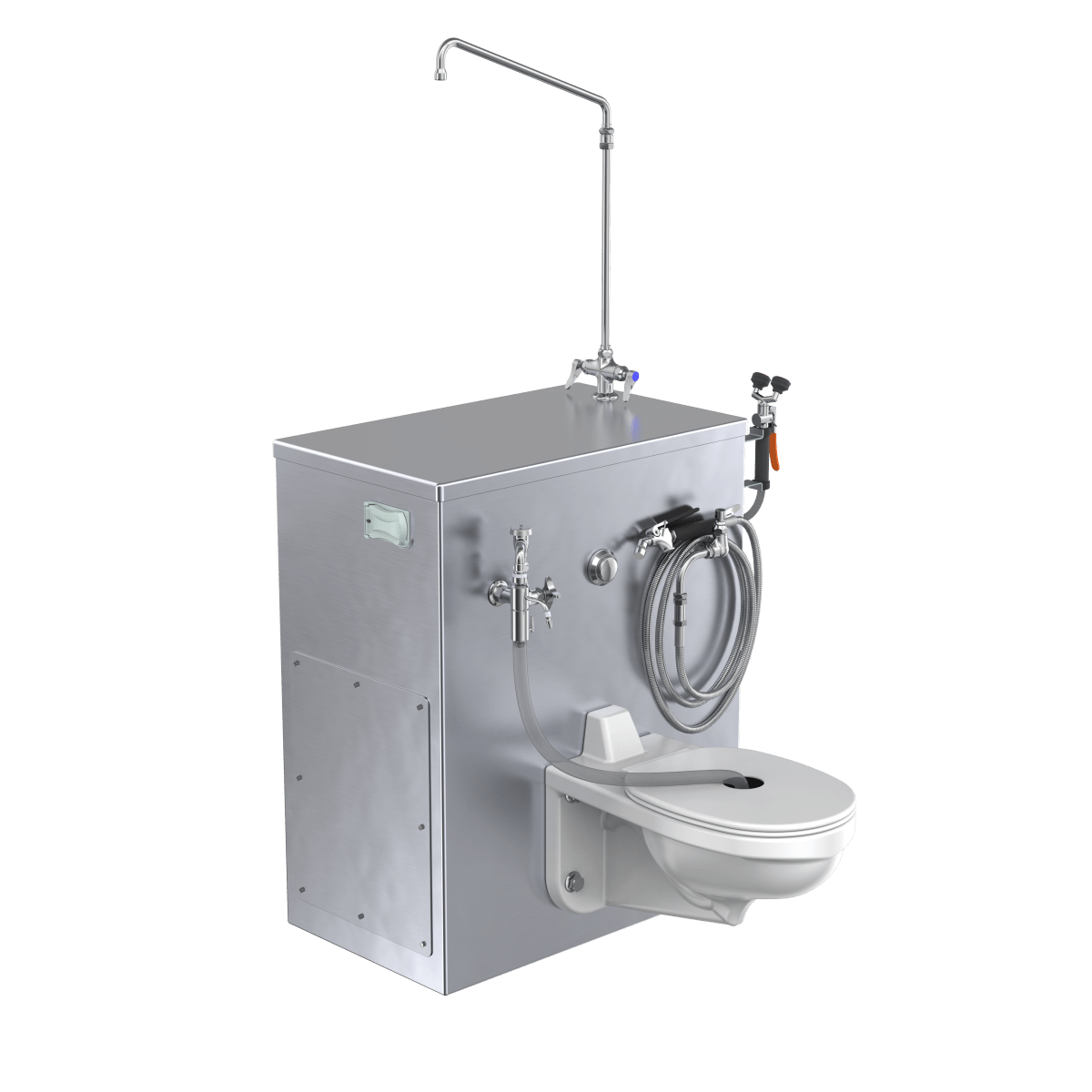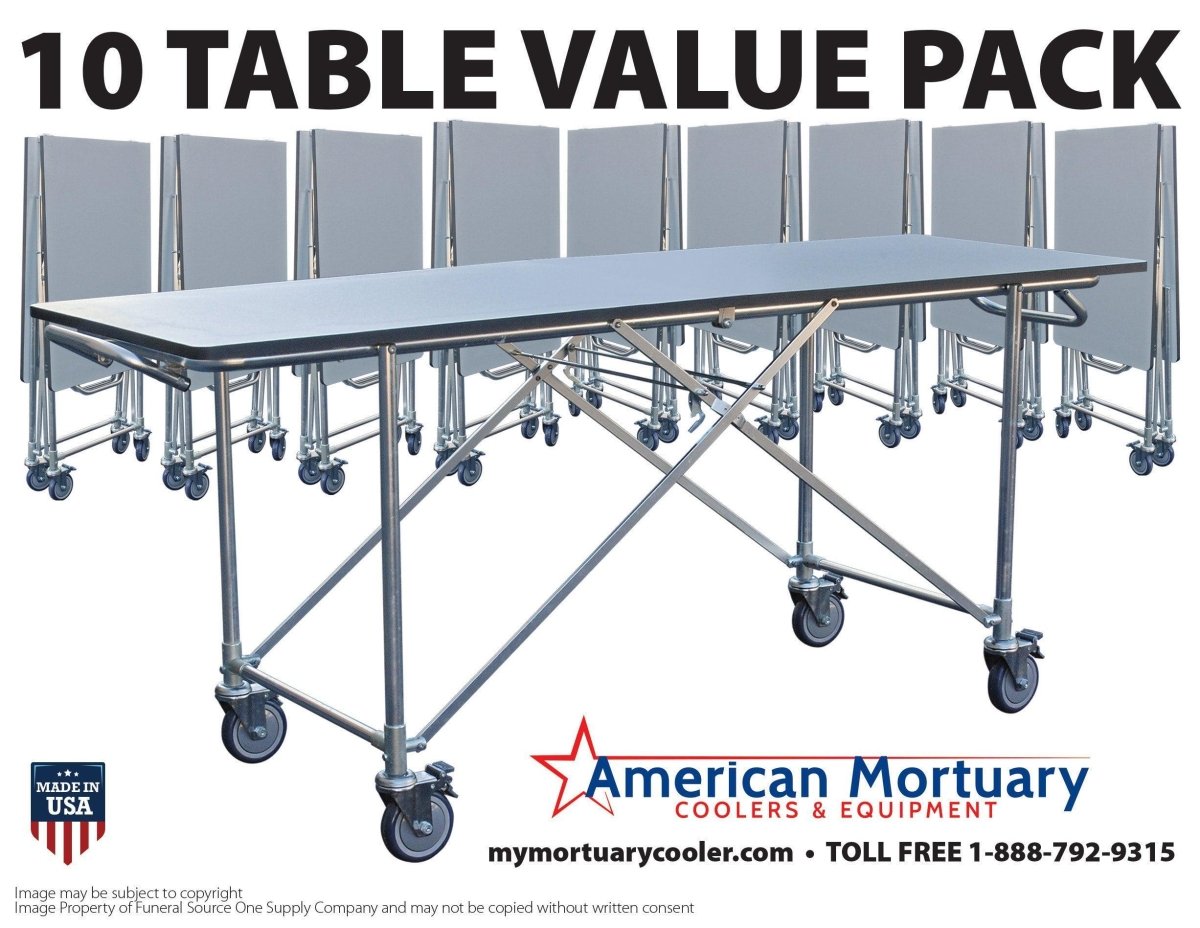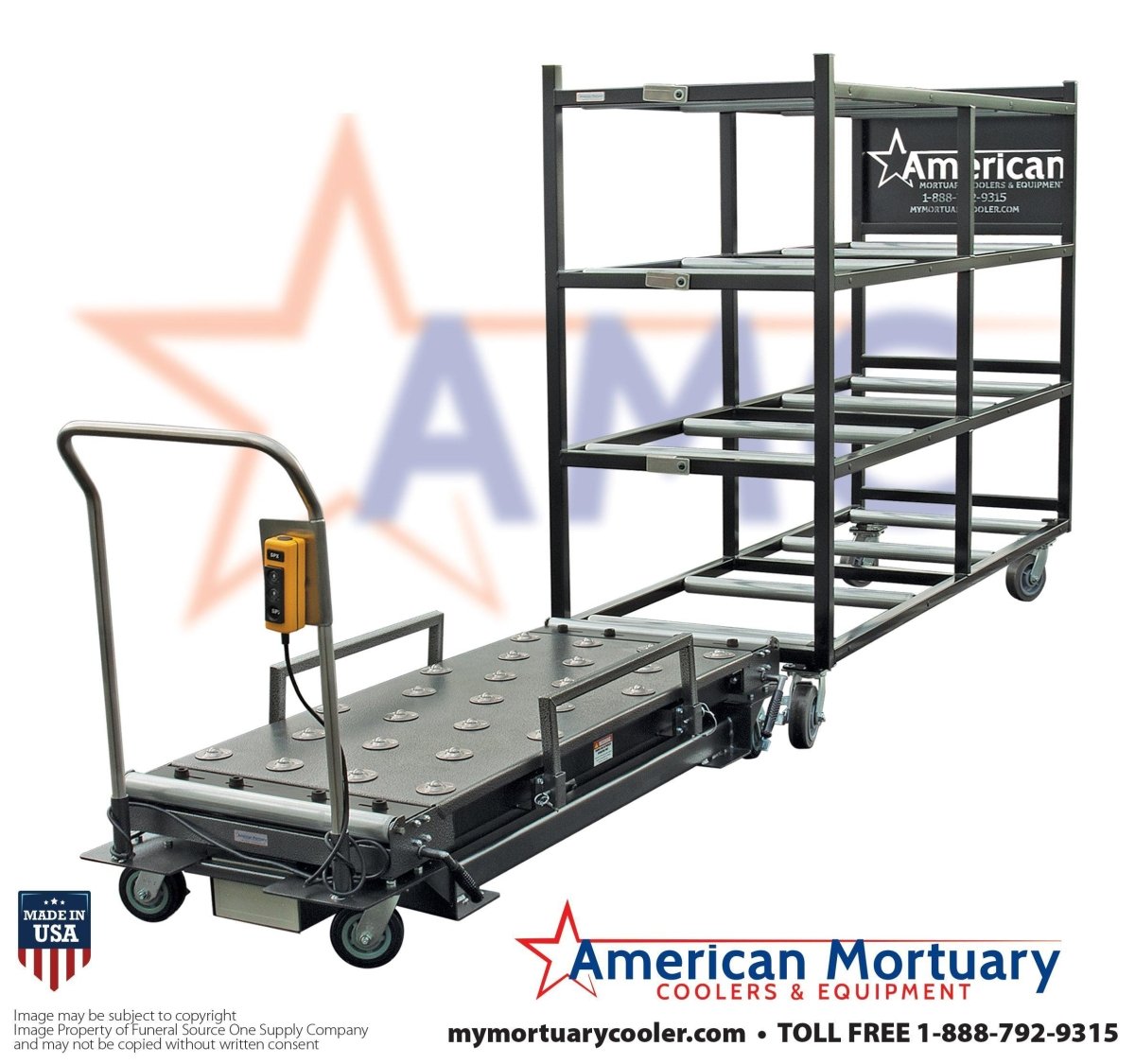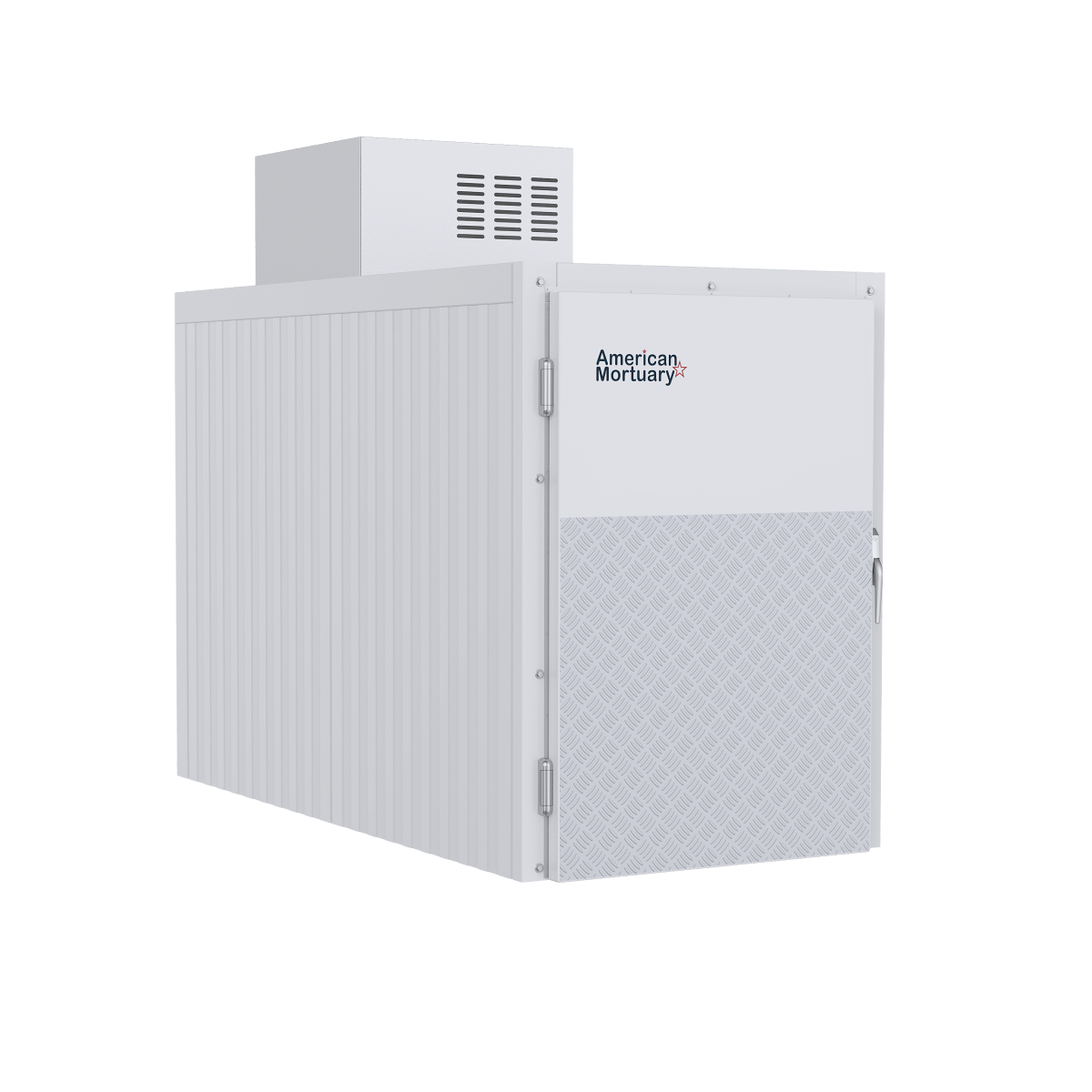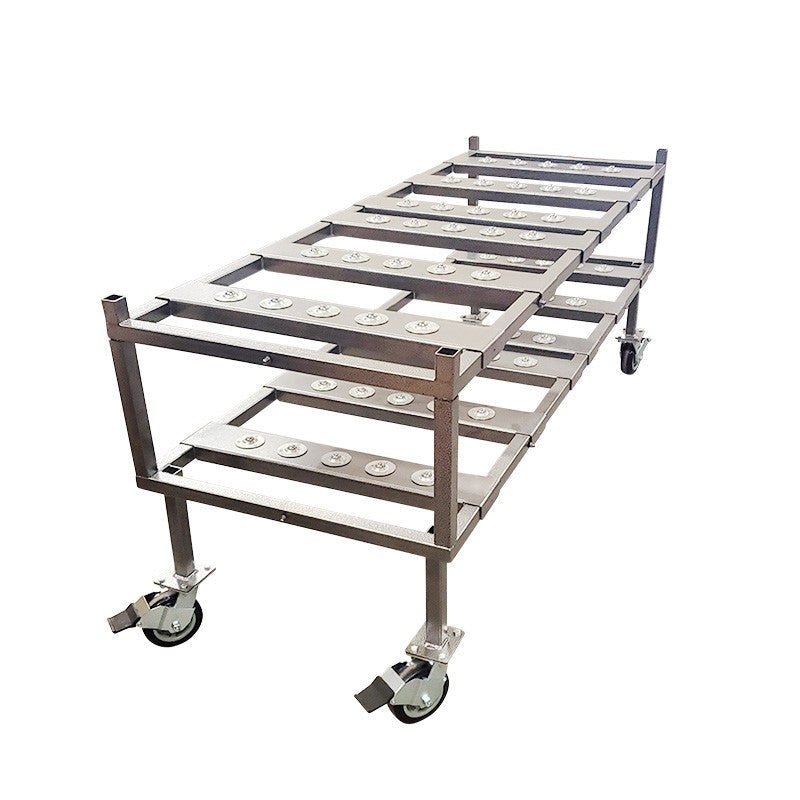In funeral homes, hospitals, medical examiners' offices, and pathology departments across the nation, efficient body transport and temporary storage represents a critical operational requirement. Yet many facilities operate with inadequate, outdated, or poorly selected mortuary cots that compromise operational efficiency, create staff safety challenges, and undermine the professional standards that families expect.
Mortuary cots represent far more than simple stretchers. Professional mortuary cots are engineered systems designed specifically for safe, efficient body transport and temporary storage in mortuary environments. The right mortuary cot enables smooth transitions between storage areas, preparation rooms, and service spaces while maintaining body dignity and protecting staff from injury.
Yet many funeral home operators and facility managers don't fully understand what distinguishes professional mortuary cots from generic medical stretchers or material handling equipment. Some facilities have attempted to adapt standard hospital stretchers for body storage, discovering that these compromises create problems affecting operations and professionalism. Others selected mortuary cots based on initial cost rather than long-term value, struggling with equipment limitations during peak operations.
This comprehensive guide addresses every aspect of mortuary cots: what distinguishes professional equipment engineered for mortuary applications, how different cot designs serve various facility needs and transport requirements, what specifications matter most for safe and efficient operations, how to select the right mortuary cot for your facility, proper use and maintenance, regulatory compliance requirements, and why investing in professional mortuary cots delivers substantial benefits to operations, safety, and professionalism.
Understanding Mortuary Cots: Essential Transport Infrastructure for Mortuary Operations
Mortuary cots are specialized equipment designed exclusively for safe, respectful body transport and temporary storage in mortuary environments. Unlike standard hospital stretchers designed for patient transport or generic material handling equipment, professional mortuary cots address the unique requirements of funeral service operations.
The engineering requirements for mortuary cots differ fundamentally from other transport equipment. Standard hospital stretchers are designed for living patients who can communicate about comfort and positioning—requirements completely different from deceased individuals requiring respectful, dignified handling. Material handling carts designed for industrial applications focus purely on load capacity without considering professionalism or dignity. Mortuary cots must balance multiple requirements simultaneously: safe load handling, respectful body positioning, professional appearance, operational efficiency, and integration with mortuary environments.
Professional mortuary cots address unique challenges that only specialists understand. Bodies vary significantly in weight and composition, requiring flexible support and positioning systems. Cots must transition smoothly between refrigerated storage, preparation areas, and service spaces, functioning reliably across temperature variations. Staff must access and position remains efficiently while maintaining professional appearance and dignity. Systems must enable smooth movement without sudden jolts or instability that disrespect remains or create safety hazards for staff.
For funeral directors and facility managers, professional mortuary cots mean:
- Safe, efficient body transport without manual lifting strains
- Professional appearance impressing families during service arrangements
- Reliable, smooth operation enabling consistent service quality
- Staff safety through proper equipment rather than manual handling
- Integration with facility operations supporting workflow efficiency
- Peace of mind knowing bodies are handled professionally and safely
What Professional Mortuary Operations Require from Mortuary Cots
Successful mortuary operations demand specific capabilities from equipment.
Safe Body Transport: The primary requirement. Bodies must transition smoothly between storage, preparation, and service areas without manual lifting strains on staff or disrespectful jostling of remains. Professional mortuary cots provide smooth, controlled transport.
Weight Capacity and Structural Support: Mortuary cots must safely support typical body weight (150-300+ pounds) plus any casket, container, or positioning devices. Heavy-duty systems supporting 500+ pounds accommodate larger bodies. Structural support must prevent instability or equipment failure during transport or positioning.
Smooth, Quiet Operation: Professional cots operate smoothly without squeaks, rattles, or jerky movement. Smooth operation demonstrates professionalism and prevents disturbing families or creating disruptive noise in professional environments.
Positioning and Access: Staff must position bodies on cots comfortably for transport and temporary storage. Cots should enable adjustable positioning accommodating various body types and conditions. Access mechanisms should facilitate smooth body positioning without awkward reaching or uncomfortable staff positioning.
Professional Appearance: Cots visible to families or staff must project professionalism and respect. Premium materials and professional finish enhance facility appearance and convey commitment to professional standards.
Temperature Stability: Mortuary cots must function reliably in refrigerated environments. Some standard equipment experiences performance degradation in cold, compromising operations. Professional mortuary cots use materials and components functioning reliably across temperature variations.
Integration with Facility Operations: Mortuary cots must coordinate seamlessly with preparation tables, storage systems, and service spaces. Proper height coordination, smooth transitions, and compatible design support efficient workflow.
Durability and Longevity: Professional cots must operate reliably for many years with proper maintenance. Durability ensures long equipment lifespan and consistent service capability.
Sanitation and Cleanliness: Mortuary cots must support thorough sanitation between bodies. Non-porous, sealed surfaces enable easy cleaning and prevent contamination between different remains.
Staff Safety: Cots must support safe operations, preventing staff injury through proper weight distribution, stable operation, and ergonomic design.
Types of Mortuary Cots: Configurations for Different Facility Needs
Professional mortuary cots come in various configurations serving different facility types and operational requirements.
Standard Mortuary Cots: The most common configuration, standard mortuary cots provide safe body transport with reliable, smooth operation. These versatile systems work exceptionally well in general funeral home operations, hospitals, and medical facilities.
Heavy-Duty Mortuary Cots: Facilities requiring capacity for larger bodies or more robust construction benefit from heavy-duty mortuary cots. These reinforced systems support 500+ pounds safely with enhanced structural support.
Refrigerated Mortuary Cots: Some facilities require integrated refrigeration in transport cots, maintaining temperature during body transitions or short-term temporary storage in non-refrigerated spaces. Refrigerated mortuary cots combine transport capability with temperature control.
Hydraulic Mortuary Cots: Advanced cots include hydraulic lift mechanisms enabling height adjustment for comfortable staff positioning during body transfer between cots and preparation surfaces. Hydraulic systems provide smooth, responsive operation.
Folding and Portable Mortuary Cots: Facilities requiring temporary transport capacity or supplemental equipment benefit from portable, folding mortuary cots. These systems maintain professional capability while providing space savings and mobility.
Stretcher Integral Systems: Some modern mortuary coolers include specialized cots designed specifically for integration with refrigerated storage, enabling direct transfer between storage and transport without additional repositioning.
Transport and Storage Combinations: Advanced facilities employ dual-purpose mortuary cots serving both transport and temporary storage functions, optimizing space utilization and operational efficiency.
Bariatric Mortuary Cots: Facilities serving larger bodies require specialized bariatric mortuary cots with reinforced construction and extended dimensions accommodating bodies exceeding 300-400 pounds safely.
Critical Specifications: Selecting Professional Mortuary Cots
Choosing appropriate mortuary cots requires understanding specifications determining safety, functionality, and operational compatibility.
Weight Capacity and Load Rating: Professional mortuary cots safely support 300-500+ pounds depending on design. Verify capacity matches typical body weight plus containers or positioning devices. Heavy-duty systems supporting 600-1000+ pounds accommodate specialized needs. Never exceed rated capacity—overload creates safety hazards.
Cot Dimensions and Body Accommodation: Standard mortuary cots accommodate 5.5-6.5 feet in length, supporting typical body dimensions. Verify length accommodates the population served. Width should provide comfortable support (24-36 inches typical).
Height Range and Adjustment Capability: Professional cots should enable height adjustment (typically 24-36 inches) for comfortable staff positioning during transfers. Adjustable height reduces back strain and improves ergonomics.
Caster Quality and Movement: Heavy-duty casters enable smooth movement while maintaining stability. Four-wheel designs with quality bearings provide responsive, smooth transport. Casters should enable one-handed controlled movement without sudden jerking.
Brake System and Stability: Professional mortuary cots include reliable brake systems preventing unintended movement during positioning or temporary parking. Brakes should engage smoothly and hold position securely.
Surface Material and Finish: Mortuary cots should feature non-porous, corrosion-resistant materials: stainless steel, medical-grade polymers, or durable epoxy coatings. Surfaces must be sealed, smooth, and easily sanitizable.
Side Rail and Safety Features: Professional cots include side rails or safety mechanisms preventing bodies from shifting during transport. Rails should be height-appropriate for bodies and removable or adjustable for casket placement.
Head and Foot Positioning: Some mortuary cots include adjustable head or foot sections enabling body positioning for dignity and support. Adjustability supports various body conditions.
Construction and Durability: Professional cots feature robust construction: reinforced frame, welded joints, durable hardware. Construction must support reliable operation under regular use without excessive vibration or instability.
Cot Locking Mechanisms: Locking mechanisms should enable secure body positioning preventing shifting during transport or temporary storage. Locks should be intuitive, operate smoothly, and remain secure throughout use.
Noise and Vibration Characteristics: Professional mortuary cots operate quietly and smoothly. Excessive noise or vibration creates unprofessional environment and disturbs families.
Design Considerations: How Mortuary Cots Integrate with Facility Operations
Professional mortuary cots don't function in isolation—they're designed to work seamlessly with complete mortuary operations.
Height Coordination with Preparation Tables: Mortuary cots should coordinate height-wise with embalming preparation tables, enabling smooth body transfer between cot and table without awkward lifting or repositioning. Height compatibility streamlines operations.
Storage Integration: Cots should transition smoothly from refrigerated storage to transport to preparation areas. Proper design facilitates efficient workflow without requiring multiple body repositionings.
Casket Placement Compatibility: When caskets are placed on cots, dimensions and structure should accommodate casket positioning safely and professionally. Removable rails enable casket placement and secure positioning.
Space Efficiency: Mortuary cots should enable efficient storage when not in use. Folding designs or compact positioning preserve facility space.
Temperature Stability: In refrigerated environments, cots must maintain functionality and smooth operation. Materials should not become brittle in cold; moving parts should not seize or stick.
Workflow Optimization: Cot positioning and design should support logical workflow: storage → cot positioning → preparation → service. System design should facilitate this progression.
Staff Ergonomics: Cot design should enable comfortable body positioning and transfer without excessive reaching, bending, or back strain. Proper height and design prevent staff injuries.
Professional Appearance: Cots visible in facility areas should project professionalism. Premium finishes and professional design convey respect and competence.
Installation, Setup, and Proper Use of Mortuary Cots
Professional mortuary cots require proper setup and operation ensuring optimal performance.
Facility Assessment: Professional deployment begins with assessment: floor conditions supporting smooth cot movement, doorway dimensions accommodating cot passage, space requirements for turning radius and positioning, temperature environment (refrigerated vs. standard), and workflow layout.
Assembly and Verification: Upon delivery, mortuary cots should be assembled by trained technicians. All components should be verified for proper function: casters rotating smoothly, brakes engaging securely, height adjustment functioning smoothly, safety rails secure.
Load Testing: Professional cots should undergo load testing verifying safe operation under rated capacity. Testing confirms structural integrity and component reliability.
Maintenance and Inspection: Regular inspection verifies continued performance: caster function, brake reliability, structural integrity, surface finish maintenance, and component wear assessment. Routine maintenance extends equipment lifespan.
Staff Training: All staff utilizing mortuary cots should receive comprehensive training: proper body positioning, safe weight distribution, brake operation, height adjustment, handling techniques preventing equipment damage, and safety procedures. Well-trained staff maximize equipment performance and longevity.
Documentation: Installation should include documentation: cot specifications, weight capacity, maintenance procedures, safety features, emergency protocols, and warranty information.
Compliance and Regulatory Standards for Mortuary Cots
Mortuary cots are subject to regulatory and safety requirements at multiple levels.
OSHA Workplace Safety Standards: Mortuary cots must comply with OSHA requirements for worker safety. Equipment should prevent injury, provide stable operation, and support safe working practices.
Load Capacity Standards: Cots must clearly display rated capacity. Operators must understand and respect capacity limitations. Equipment used beyond rated capacity creates safety hazards.
State Funeral Service Licensing: Some states include equipment standards in funeral service licensing requirements. Professional mortuary cots demonstrate commitment to professional standards and regulatory compliance.
Healthcare Facility Standards: Facilities serving hospitals or medical examiners' offices face healthcare facility standards. Professional mortuary cots meet these standards as baseline features.
Universal Precautions: Bloodborne Pathogen standards apply to mortuary operations. Mortuary cot surfaces and design must support universal precautions and safe practices.
Common Problems with Mortuary Cots and Solutions
Understanding common issues helps facilities maintain equipment and address problems effectively.
Squeaky or Noisy Operation: Noise indicates caster wear, brake friction, or joint deterioration. Solutions include caster replacement, brake adjustment, or lubrication of moving parts.
Jerky or Unstable Movement: Unstable cot movement indicates caster problems, brake issues, or structural damage. Solutions include caster replacement, brake service, or structural repair.
Height Adjustment Problems: If hydraulic or mechanical height adjustment becomes difficult or sluggish, hydraulic fluid may need replacement, adjustment mechanisms may need service, or bearings may need lubrication.
Corrosion or Surface Degradation: Exposure to mortuary environment can corrode surfaces. Solutions include protective coating application, regular cleaning, or surface replacement.
Brake Failure or Slipping: Brakes should hold position securely. Failure indicates brake wear or adjustment problems. Solutions include brake replacement or adjustment.
Caster Failure or Flat Spots: Casters can wear, developing flat spots or failing entirely. Solutions include caster replacement with quality replacements.
Structural Damage or Warping: Impact damage or rough handling can cause structural problems. Solutions include inspection, possible structural repair, or equipment replacement.
Evaluating Mortuary Cot Providers: Quality and Expertise
Selecting quality mortuary cots requires careful provider evaluation.
Mortuary Industry Specialization: Providers specializing in mortuary equipment understand funeral service needs better than generalists. Specialists understand professional standards and regulatory environment.
Design and Engineering Expertise: Quality providers employ engineers understanding mortuary operational requirements. Equipment should be designed specifically for mortuary applications.
Materials and Construction Quality: Premium providers use high-quality materials: stainless steel, medical-grade polymers, heavy-duty components. Quality construction ensures durability and reliability.
References and Track Record: Reputable providers demonstrate successful installations across diverse facility types. References validate expertise and quality.
Support and Service: Professional providers offer responsive support, readily available replacement parts, and maintenance service. Long-term support demonstrates commitment.
Warranty and Liability: Comprehensive warranties covering equipment and labor indicate provider confidence and professionalism.
Cost Transparency and Value: Quality providers explain cost factors and demonstrate value justifying investment.
American Mortuary Coolers: Mortuary Cot Excellence
American Mortuary Coolers specializes in professional mortuary cots engineered specifically for funeral service body transport and temporary storage. Our cots are designed with deep understanding of mortuary operations, facility requirements, and professional standards that enable safe, efficient operations.
Our professional mortuary cots feature:
- Heavy-duty construction supporting 300-500+ pounds safely
- Smooth, quiet operation enabling professional appearance
- Height adjustment enabling comfortable staff positioning
- Reliable braking systems preventing unintended movement
- Non-porous, corrosion-resistant materials for easy sanitation
- Smooth-rolling casters enabling responsive, controlled movement
- Professional finish projecting competence and respect
- Dimensions accommodating standard and larger bodies
- Integration compatibility with preparation tables and storage
- Cold-temperature rated components for refrigerated environments
- Folding or portable configurations available for space efficiency
- 10-20 year equipment lifespan with proper maintenance
Our experienced technicians deliver professional mortuary cots, ensure proper setup and verification, provide comprehensive staff training, and offer ongoing support ensuring long-term reliability.
Best Practices: Maximizing Mortuary Cot Performance
Professional mortuary cots deliver maximum benefit when used and maintained properly.
Proper Body Positioning: Bodies should be positioned securely on cots with side rails engaged, preventing shifting during transport. Proper positioning ensures dignity and safety.
Smooth, Controlled Transport: Staff should transport cots smoothly without sudden acceleration, jerking, or rough handling. Smooth operation protects bodies and demonstrates professionalism.
Brake Engagement: Brakes should be engaged whenever cots are parked temporarily or positioned for body transfer. Secure positioning prevents unintended movement.
Regular Cleaning and Sanitation: Mortuary cots should be thoroughly cleaned and sanitized between bodies. Regular sanitation prevents bacterial growth and maintains professional standards.
Caster and Hardware Inspection: Regular visual inspection identifies developing problems: caster wear, corrosion, hardware loosening, or brake issues. Early detection enables prompt repair.
Preventive Maintenance: Following manufacturer maintenance recommendations—lubrication, adjustment, component inspection—prevents most problems and extends equipment lifespan.
Load Capacity Respect: Never exceed rated capacity. Overloading creates safety hazards and equipment damage. Single bodies plus caskets should remain within rated capacity.
Safe Operating Practices: Staff should use cots only as designed, never remove or disable safety features, and report any abnormal operation immediately. Proper use maximizes equipment longevity.
Staff Training: All staff using mortuary cots should understand proper operation, safety procedures, maintenance requirements, and emergency protocols. Well-trained staff maximize equipment performance.
Documentation: Maintain maintenance records documenting service, repairs, and any issues. Documentation proves proper care and enables proactive maintenance.
Emerging Trends: Innovation in Mortuary Cot Design
The mortuary equipment industry continues advancing with new cot innovations.
Refrigerated Transport Cots: Integrated refrigeration enabling temperature-controlled transport during body transitions or temporary storage in non-refrigerated spaces represents significant innovation.
Hydraulic Height Adjustment: Electric or hydraulic height adjustment enables smooth positioning without manual cranking, reducing staff effort and improving operational efficiency.
Advanced Material Science: Modern mortuary cots increasingly feature advanced polymers and materials offering superior durability, easier sanitation, and better temperature stability.
Ergonomic Design Advances: Contemporary cots emphasize staff ergonomics: optimal heights reducing back strain, smooth operation reducing physical effort, and comfortable positioning.
Modular Design: Some advanced cots feature modular design enabling customization for facility-specific requirements.
Smart Components: Integration of monitoring systems tracking cot usage and maintenance needs represents emerging trend in facility management.
The Financial Case: Understanding Mortuary Cot Investment Value
Professional mortuary cots represent significant investment justified by substantial operational benefits.
Initial Equipment Cost: Quality mortuary cots range from $2,000 to $15,000+ depending on features and specifications. While substantial, this represents reasonable investment amortized over 10-20 year lifespan.
Staff Safety and Injury Prevention: Proper mortuary cots eliminate manual lifting strains, back injuries, and physical trauma to staff. Injury prevention reduces workers' compensation claims costing significant resources.
Operational Efficiency: Smooth, efficient body transport reduces staff time per service transition, increasing operational capacity directly increasing revenue.
Staff Retention and Satisfaction: Proper equipment improving working conditions reduces staff turnover. Reducing recruitment and training costs (exceeding $10,000 per staff member) justifies equipment investment.
Professional Reputation: Professional equipment projects competence generating community reputation and positive family perception.
Insurance and Liability: Proper equipment demonstrates duty of care, potentially reducing insurance premiums and preventing liability claims.
Equipment Longevity: Quality cots lasting 10-20 years spread costs over decades. Annual equipment cost is remarkably reasonable.
ROI Example: A $5,000 mortuary cot preventing staff injuries (potential savings $50,000+ per prevented injury), reducing transport time by 20% (enabling additional 2-3 services monthly = $6,000-$9,000 monthly revenue increase), and improving professional reputation (generating 5+ referral services monthly = $15,000) generates $100,000+ in annual benefits paying for equipment in weeks.
Making Your Decision: Selecting Quality Mortuary Cots
Before selecting mortuary cots, ensure you've considered:
- What is your typical body weight range and size variation?
- Do you require standard or bariatric (heavy-duty) capacity?
- What height adjustment range would benefit your operations?
- How many mortuary cots does your facility require?
- Do you need portable/folding capability or fixed systems?
- What is your facility's temperature environment (refrigerated vs. standard)?
- Can providers demonstrate successful installations in similar facilities?
- What warranties and support are offered?
- What is total cost of ownership including maintenance?
- What staff training will be provided?
Taking time to answer these questions ensures you select mortuary cots serving your facility safely and professionally for decades.
Conclusion: Professional Mortuary Cots as Essential Operational Infrastructure
Mortuary cots represent essential infrastructure determining operational efficiency, staff safety, and professional service capability. Selecting professional mortuary cots engineered specifically for funeral service, using them properly, maintaining them proactively, and supporting staff with training ensures reliable performance and professional operations for 10-20+ years.
The distinction between professional mortuary cots and generic equipment becomes evident immediately in smooth operation, professional appearance, staff safety, and operational efficiency. Facilities that invest in professional mortuary cots from specialists enjoy operational advantages, staff safety benefits, professional reputation improvements, and long-term cost savings justifying investment many times over.
Whether you're opening a new funeral home, upgrading aging facilities, or expanding transport capacity, professional mortuary cots enable your facility to operate professionally and safely. American Mortuary Coolers specializes in mortuary cots engineered for your specific operational needs and supported by technicians understanding funeral service requirements.
Contact American Mortuary Coolers today to discuss how professional mortuary cots can transform your facility's operational efficiency and professionalism.
CALL-TO-ACTION SECTION
Ready to upgrade your facility with professional mortuary cots?
American Mortuary Coolers specializes exclusively in professional mortuary cots and body transport solutions engineered for safe, efficient funeral service operations.
Our professional mortuary cots include:
- Heavy-duty construction supporting 300-500+ pounds safely
- Smooth, quiet operation maintaining professional appearance
- Height adjustment enabling ergonomic staff positioning
- Reliable braking systems ensuring secure positioning
- Non-porous, corrosion-resistant materials for easy sanitation
- Smooth-rolling casters enabling responsive, controlled movement
- Standard and bariatric capacity options
- Folding/portable configurations available
- Cold-temperature rated components for refrigerated environments
- Professional finish projecting competence and respect
- Integration compatible with preparation tables and facility systems
- 10-20 year equipment lifespan with proper maintenance
Contact American Mortuary Coolers today for your mortuary cot solution:
📞 Phone: 1-888-792-9315 📧 Email: cool@mymortuarycooler.com 🌐 Website: mymortuarycooler.com
Our specialists understand funeral home operations and the importance of reliable, professional body transport equipment. We'll assess your facility's needs, recommend ideal solutions, and provide transparent pricing.
Why funeral professionals choose American Mortuary Coolers for mortuary cots:
- Purpose-built engineering for funeral service body transport
- Heavy-duty, reliable construction supporting demanding use
- Professional appearance projecting competence and respect
- Staff safety through proper equipment design
- Smooth, quiet operation maintaining professionalism
- Cold-temperature rated components for all environments
- Multiple capacity and configuration options
- Professional installation and comprehensive staff training
- Responsive support and readily available parts
- 10-20 year equipment lifespan ensuring long-term value
Invest in professional mortuary cots enabling safe, efficient, professional operations.
American Mortuary Coolers: Professional Mortuary Cots for Operational Excellence


